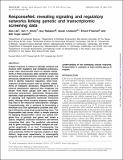| dc.contributor.author | Lan, Alex | |
| dc.contributor.author | Smoly, Ilan Y. | |
| dc.contributor.author | Rapaport, Guy | |
| dc.contributor.author | Fraenkel, Ernest | |
| dc.contributor.author | Lindquist, Susan | |
| dc.contributor.author | Yeger-Lotem, Esti | |
| dc.date.accessioned | 2012-05-25T19:34:16Z | |
| dc.date.available | 2012-05-25T19:34:16Z | |
| dc.date.issued | 2011-05 | |
| dc.date.submitted | 2011-04 | |
| dc.identifier.issn | 0305-1048 | |
| dc.identifier.issn | 1362-4962 | |
| dc.identifier.uri | http://hdl.handle.net/1721.1/70953 | |
| dc.description.abstract | Cellular response to stimuli is typically complex and involves both regulatory and metabolic processes. Large-scale experimental efforts to identify components of these processes often comprise of genetic screening and transcriptomic profiling assays. We previously established that in yeast genetic screens tend to identify response regulators, while transcriptomic profiling assays tend to identify components of metabolic processes. ResponseNet is a network-optimization approach that integrates the results from these assays with data of known molecular interactions. Specifically, ResponseNet identifies a high-probability sub-network, composed of signaling and regulatory molecular interaction paths, through which putative response regulators may lead to the measured transcriptomic changes. Computationally, this is achieved by formulating a minimum-cost flow optimization problem and solving it efficiently using linear programming tools. The ResponseNet web server offers a simple interface for applying ResponseNet. Users can upload weighted lists of proteins and genes and obtain a sparse, weighted, molecular interaction sub-network connecting their data. The predicted sub-network and its gene ontology enrichment analysis are presented graphically or as text. Consequently, the ResponseNet web server enables researchers that were previously limited to separate analysis of their distinct, large-scale experiments, to meaningfully integrate their data and substantially expand their understanding of the underlying cellular response. ResponseNet is available at http://bioinfo.bgu.ac.il/respnet. | en_US |
| dc.description.sponsorship | Seventh Framework Programme (European Commission) (grant agreement 256360) | en_US |
| dc.description.sponsorship | United States-Israel Binational Science Foundation (BSF) (2009323) | en_US |
| dc.language.iso | en_US | |
| dc.publisher | Oxford University Press (OUP) | en_US |
| dc.relation.isversionof | http://dx.doi.org/10.1093/nar/gkr359 | en_US |
| dc.rights | Creative Commons Attribution Non-Commercial | en_US |
| dc.rights.uri | http://creativecommons.org/licenses/by-nc/2.5 | en_US |
| dc.source | Oxford | en_US |
| dc.title | ResponseNet: revealing signaling and regulatory networks linking genetic and transcriptomic screening data | en_US |
| dc.type | Article | en_US |
| dc.identifier.citation | Lan, A. et al. “ResponseNet: Revealing Signaling and Regulatory Networks Linking Genetic and Transcriptomic Screening Data.” Nucleic Acids Research 39.Web Server (2011): W424–W429. Web. 25 May 2012. | en_US |
| dc.contributor.department | move to dc.description.sponsorship | en_US |
| dc.contributor.department | Massachusetts Institute of Technology. Department of Biological Engineering | en_US |
| dc.contributor.department | Massachusetts Institute of Technology. Department of Biology | en_US |
| dc.contributor.approver | Lindquist, Susan | |
| dc.contributor.mitauthor | Lindquist, Susan | |
| dc.contributor.mitauthor | Yeger-Lotem, Esti | |
| dc.relation.journal | Nucleic Acids Research | en_US |
| dc.eprint.version | Final published version | en_US |
| dc.type.uri | http://purl.org/eprint/type/JournalArticle | en_US |
| eprint.status | http://purl.org/eprint/status/PeerReviewed | en_US |
| dspace.orderedauthors | Lan, A.; Smoly, I. Y.; Rapaport, G.; Lindquist, S.; Fraenkel, E.; Yeger-Lotem, E. | en |
| dc.identifier.orcid | https://orcid.org/0000-0003-1307-882X | |
| mit.license | PUBLISHER_CC | en_US |
| mit.metadata.status | Complete | |
